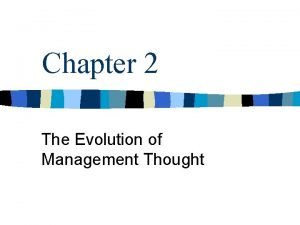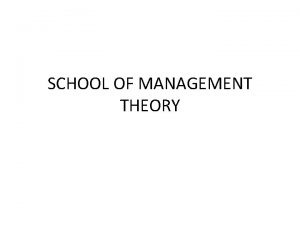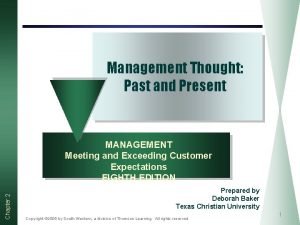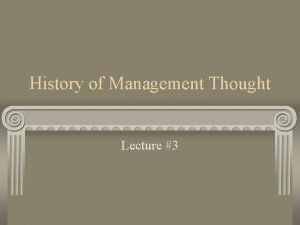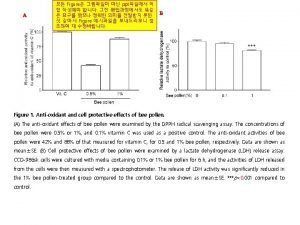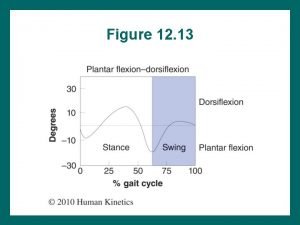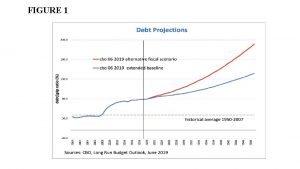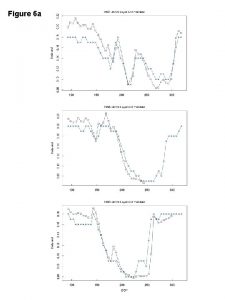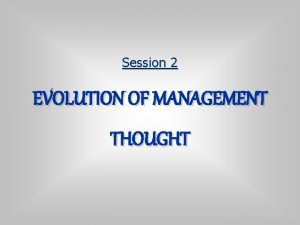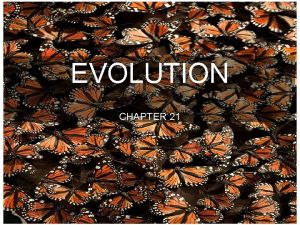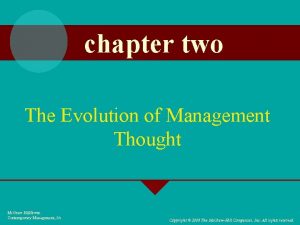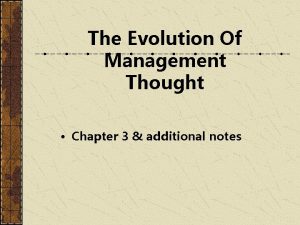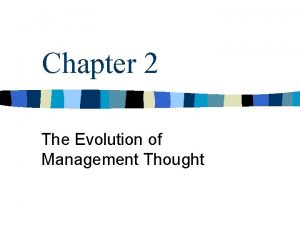Chapter 2 The Evolution of Management Thought Figure






































- Slides: 38

Chapter 2 The Evolution of Management Thought

Figure 2. 1 Management is a Global Affair

The Practice and Study of Management • The systematic study of management did not begin in earnest until after 1900. • The practice of management is much older, stretching as far back as the construction of the pyramids. Copyright © Houghton Mifflin Company. All rights reserved. 3

The Practice and Study of Management (cont’d) • Information Overload • Management has not had a systematically recorded body of knowledge until recently. • Today, vast amounts of relevant information are readily available in print and electronic media. • An Interdisciplinary Field • The manifold increase in management theory information is due largely to its interdisciplinary nature in drawing from several fields (e. g. , psychology, mathematics, economics, history, and engineering). Copyright © Houghton Mifflin Company. All rights reserved. 4

No Universally Accepted Theory of Management • There are several approaches to theory and practice of management. • The universal process approach • The operational approach • The behavioral approach • The systems approach • The contingency approach • The attributes of excellence approach Copyright © Houghton Mifflin Company. All rights reserved. 5

The Universal Process Approach • Assumes all organizations require the same rational management process. • Core management process remains the same regardless of the purpose of the organization. • The management process can be reduce to a set of separate functions and related principles. Copyright © Houghton Mifflin Company. All rights reserved. 6

Henri Fayol’s Universal Management Process • Fayol published Administration Industrielle et Générale in 1916. • Divided manager’s job into five functions: • Planning, organizing, command, coordination, and control. • Developed 14 universal principles of management. Copyright © Houghton Mifflin Company. All rights reserved. 7



Henri Fayol’s Universal Management Process (cont’d) • Lessons from the Universal Process Approach • The management process can be separated into interdependent functions. • Management is a continuous process. • Management is a largely, though not an entirely, rational process. • The functional approach is useful because it specifies what managers should do. Copyright © Houghton Mifflin Company. All rights reserved. 10

The Operational Approach • Frederick W. Taylor’s Scientific Management • Developing performance standards on the basis of systematic observations and experimentation. • Standardization of work practices and methods reduce waste and increase productivity • Time and task study of workers’ efforts to maximize productivity and output. • Systematic selection and training of workers to increase efficiency and productivity. • Differential pay incentives based on established work standards. Copyright © Houghton Mifflin Company. All rights reserved. 11

Figure 2. 2 Taylor’s Differential Piece-Rate Plan Copyright © Houghton Mifflin Company. All rights reserved. 12

Taylor’s Followers • Frank and Lillian Gilbreth • Refined time and motion study methods for use in work simplification. • Henry L. Gant • Refined production control and cost control techniques. • Developed the Gantt chart for work-scheduling of projects. • Early advocate of the importance of the human factor and the importance of customers service over profits. Copyright © Houghton Mifflin Company. All rights reserved. 13

The Quality Advocates • Walter A. Shewhart • Introduced the concept of statistical quality control. • Kaoru Ishikawa • Proposed a preventive approach to quality. • Developed fishbone diagram approach to problemsolving. • W. Edwards Deming • Based his 14 principles on reformed management style, employee participation, and striving for continuous improvement. Copyright © Houghton Mifflin Company. All rights reserved. 14

The Quality Advocates (cont’d) • Joseph M. Juran • Proposed the concept of internal customers, teamwork, partnerships with suppliers, and brainstorming. • Developed Pareto analysis (80/20 rule) as a tool for separating major problems from minor ones. • Armand V. Feigenbaum • Developed the concept of total quality control. • Philip B. Crosby • Promoted the idea of zero defects (doing it right the first time). Copyright © Houghton Mifflin Company. All rights reserved. 15

The Operational Approach (cont’d) • Lessons from the Operational Approach • A dedication to finding a better way is still important. • Using scientific management doesn’t dehumanize workers. • Quality advocates, inspired by the scientific approach, have been right all along about the importance of quality and continuous improvement • The operational approach fostered the development of operations management. Copyright © Houghton Mifflin Company. All rights reserved. 16

The Behavioral Approach • The Human Relations Movement • An effort to make managers more sensitive to their employees’ needs. • Arose out the influences of • the threat of unionization. • the Hawthorne studies. • the philosophy of industrial humanism. Copyright © Houghton Mifflin Company. All rights reserved. 17

Figure 2. 3 The Human Relations Movement Pyramid

The Behavioral Approach (cont’d) • The Threat of Unionization • The Wagner Act of 1935 legalized union-management collective bargaining, promoting the growth of unions and union avoidance by firms. • The Hawthorne Studies (1924) • The study’s results that productivity was strongly affected by workers’ attitudes turned management toward the humanistic and realistic viewpoint of the “social man” model. Copyright © Houghton Mifflin Company. All rights reserved. 19

The Philosophy of Industrial Humanism • Elton Mayo • Emotional factors were more important determinants of productive efficiency than were physical and logical factors. • Mary Parker Follett • Managers should be aware of how complex each employee is and how to motivate employees to cooperate rather than to demand performance from them. Copyright © Houghton Mifflin Company. All rights reserved. 20

The Philosophy of Industrial Humanism (cont’d) • Douglas Mc. Gregor • Developed Theory X and Theory Y • Theory X: management’s traditionally negative view of employees as unmotivated and unwilling workers. • Theory Y: the positive view of employees as energetic, creative, and willing workers. Copyright © Houghton Mifflin Company. All rights reserved. 21


Organizational Behavior • Organization Behavior • A modern research-oriented approach seeking to discover the causes of work behavior and to develop better management techniques. • Lessons from the Behavioral Approach • People are the key to productivity. • Success depends on motivated and skilled individuals committed to the organization. • Managerial sensitivity to employees is necessary to foster the cooperation needed for high productivity. Copyright © Houghton Mifflin Company. All rights reserved. 23

The Systems Approach • What is a System? • A collection of parts that operate interdependently to achieve a common purpose. • Systems Approach • Posits that the performance of the whole is greater that the sum of the performance of its parts. • Analytic versus synthetic thinking: outside-in thinking versus inside-out thinking. • Seeks to identify all parts of an organized activity and how they interact. Copyright © Houghton Mifflin Company. All rights reserved. 24

The Systems Approach • Chester I. Barnard’s Early Systems Perspective • Wrote Functions of the Executive. • Characterized all organizations as cooperative systems. • Defined principle elements in an organization as • willingness to serve. • common purpose. • communication. • Strong advocate of business ethics. Copyright © Houghton Mifflin Company. All rights reserved. 25

Figure 2. 4 Barnard’s Cooperative System Copyright © Houghton Mifflin Company. All rights reserved. 26

General Systems Theory • An area of study based on the assumptions that everything is part of a larger, interdependent arrangement. • Levels of systems • Each system is a subsystem of the system above it. • Identification of systems at various levels helps translate abstract systems theory into more concrete terms. Copyright © Houghton Mifflin Company. All rights reserved. 27

Figure 2. 5 Levels of Living Systems Copyright © Houghton Mifflin Company. All rights reserved. 28

General Systems Theory (cont’d) • Closed Versus Open Systems • Closed system • A self-sufficient entity. • Open system • Something that depends on its surrounding environment for survival. • Systems are classified open (closed) by how much (how little) they interact with their environments. Copyright © Houghton Mifflin Company. All rights reserved. 29

General Systems Theory (cont’d) • New Directions in Systems Thinking • Organizational learning and knowledge management • Organizations are living and thinking open systems that learn from experience and engage in complex mental processes. • Chaos theory • Every complex system has a life of its own, with its own rule book. • Complex adaptive systems • Complex systems are self-organizing. Copyright © Houghton Mifflin Company. All rights reserved. 30


The Contingency Approach • A research effort to determine which managerial practices and techniques are appropriate in specific situations. • Different situations require different managerial responses. • Can deal with intercultural feelings in which custom and habits cannot be taken for granted. Copyright © Houghton Mifflin Company. All rights reserved. 32

The Contingency Approach (cont’d) • Contingency Characteristics • An open-system perspective • How subsystems combine to interact with outside systems. • A practical research orientation • Translating research findings into tools and situational refinements for more effective management. • A multivariate approach • Many variables collectively account for variations in performance. Copyright © Houghton Mifflin Company. All rights reserved. 33

The Contingency Approach (cont’d) • Lessons from the Contingency Approach • Approach emphasizes situational appropriateness rather than rigid adherence to universal principles. • Approach creates the impression that an organization is captive to its environment. Copyright © Houghton Mifflin Company. All rights reserved. 34

Attributes of Excellence: A Modern Unconventional Approach • Peter and Waterman’s Approach • Attacked conventional management theory and practice as outmoded in almost every dimension. • Replaced conventional management terminology with new catch phrases. • Made key points with anecdotes and stories rather than quantifiable objective data and facts. Copyright © Houghton Mifflin Company. All rights reserved. 35

Attributes of Excellence: A Modern Unconventional Approach (cont’d) • A Critical Appraisal of the Excellence Approach • Raises more questions than it answers. • Ignores the contingency approach to management. • Relies heavily on unsupported generalizations. • Fails to position management effectiveness as important to sustaining corporate excellence. Copyright © Houghton Mifflin Company. All rights reserved. 36

Attributes of Excellence: A Modern Unconventional Approach (cont’d) • Lessons from the Excellence Approach • Reminded managers to pay close attention to the basics. • Reminded managers of the importance of on-the-job experimentation. Copyright © Houghton Mifflin Company. All rights reserved. 37

Figure 2. 6 The Contingency View: A Compromise Copyright © Houghton Mifflin Company. All rights reserved. 38
 Evolution of management thoughts
Evolution of management thoughts What is an incomplete thought
What is an incomplete thought Social forces behind management thought
Social forces behind management thought Schools of management theory
Schools of management theory Quantitative school of management thought
Quantitative school of management thought History of management thought
History of management thought Taylor shovel experiment
Taylor shovel experiment Hát kết hợp bộ gõ cơ thể
Hát kết hợp bộ gõ cơ thể Slidetodoc
Slidetodoc Bổ thể
Bổ thể Tỉ lệ cơ thể trẻ em
Tỉ lệ cơ thể trẻ em Gấu đi như thế nào
Gấu đi như thế nào Tư thế worms-breton
Tư thế worms-breton Hát lên người ơi alleluia
Hát lên người ơi alleluia Môn thể thao bắt đầu bằng từ chạy
Môn thể thao bắt đầu bằng từ chạy Thế nào là hệ số cao nhất
Thế nào là hệ số cao nhất Các châu lục và đại dương trên thế giới
Các châu lục và đại dương trên thế giới Cong thức tính động năng
Cong thức tính động năng Trời xanh đây là của chúng ta thể thơ
Trời xanh đây là của chúng ta thể thơ Mật thư tọa độ 5x5
Mật thư tọa độ 5x5 Phép trừ bù
Phép trừ bù Phản ứng thế ankan
Phản ứng thế ankan Các châu lục và đại dương trên thế giới
Các châu lục và đại dương trên thế giới Thể thơ truyền thống
Thể thơ truyền thống Quá trình desamine hóa có thể tạo ra
Quá trình desamine hóa có thể tạo ra Một số thể thơ truyền thống
Một số thể thơ truyền thống Cái miệng bé xinh thế chỉ nói điều hay thôi
Cái miệng bé xinh thế chỉ nói điều hay thôi Vẽ hình chiếu vuông góc của vật thể sau
Vẽ hình chiếu vuông góc của vật thể sau Thế nào là sự mỏi cơ
Thế nào là sự mỏi cơ đặc điểm cơ thể của người tối cổ
đặc điểm cơ thể của người tối cổ Thế nào là giọng cùng tên?
Thế nào là giọng cùng tên? Vẽ hình chiếu đứng bằng cạnh của vật thể
Vẽ hình chiếu đứng bằng cạnh của vật thể Vẽ hình chiếu vuông góc của vật thể sau
Vẽ hình chiếu vuông góc của vật thể sau Thẻ vin
Thẻ vin đại từ thay thế
đại từ thay thế điện thế nghỉ
điện thế nghỉ Tư thế ngồi viết
Tư thế ngồi viết Diễn thế sinh thái là
Diễn thế sinh thái là Dot
Dot
